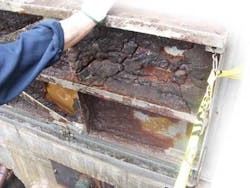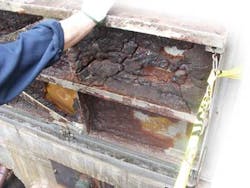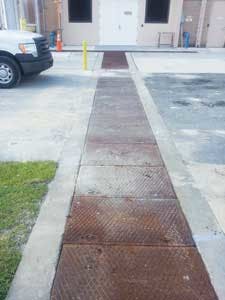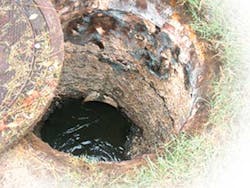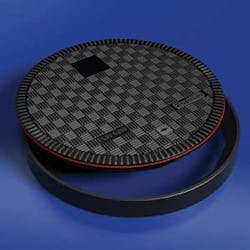Putting the Lid on Corrosion: Using Composite Manhole Covers to Help Control Corrosion Costs
One of the primary problems facing the United States today is our country's aging infrastructure. Across the nation, bridges, highways, rail lines, water lines, and sewer systems are deteriorating at a rapid pace. Likewise, one of the principal factors related to the deterioration of infrastructure is corrosion.
According to a study by the National Association of Corrosion Engineers (NACE), the direct cost of infrastructure corrosion was over $22 billion in 2002 in the United States alone.¹ Adjusted for inflation, the direct cost of corrosion in 2013 is estimated to be over $42 billion on an annual basis. While corrosion is so prevalent and variable in form that its occurrence and associated costs cannot be eliminated completely, it has been estimated that at least 25 percent to 30 percent of annual corrosion costs could be saved if optimal corrosion management practices were employed.²
Corrosion is the gradual destruction of metals and other materials caused by a chemical reaction with the air and surrounding physical environment. In the most common use of the word, corrosion means the electrochemical oxidation of metals in reaction with an oxidant such as oxygen. Rusting - the formation of iron oxides - is a well-known example of electrochemical corrosion. This type of damage usually turns the exposed metal surface into oxides or salts. Corrosion can be concentrated locally to form a pit or crack, or it can extend across a wide area more or less uniformly corroding the entire surface of the steel or cast iron product. The destruction caused by corrosion will eventually lead to the need to replace or rebuild the affected metal product.
While most metals corrode simply by exposure to moisture in the air, the corrosion process can be strongly affected by exposure to certain liquids. Liquids that cause rust must have a supply of oxygen ions in the liquid. The most common liquid that contains a supply of oxygen ions is H2O or water. When salt is added to water, the dissolved salt accelerates the rate at which oxidation occurs. In addition, chemicals that are acids (e.g., sulfuric or hydrochloric acid) or bases (e.g., sodium or potassium hydroxide) can greatly accelerate the oxidation process.
The underground infrastructure of the United States is particularly exposed to corrosion because its core components are often installed in contact with soil and convey water or more corrosive liquids, and many components such as manhole covers, frames and grates are installed at grade and are completely exposed to the elements. The scale of the affected systems that are subject to corrosion and decay is immense. According to the American Waterworks Association (AWWA), there are approximately 876,000 miles of municipal water piping in the U.S. The country's sewer system network is estimated to exceed 800,000 miles of underground piping.³
Telecoms, electrical utilities, energy companies, and many other industries also utilize extensive networks of underground piping and conduit systems to distribute electricity, energy and data. Typically, manhole covers are installed roughly every 100 feet to allow for accessing the underground pipeline or conduit. Further, it is estimated that there are at least 100 million manhole covers and grates installed in the United States alone.
The principal materials used to build the millions of manhole covers, frames and other access covers in these underground systems are steel, cast iron and concrete. All of these materials, including to a lesser extent concrete, are subject to corrosion. When manhole covers or grates are used in areas with vehicular access, they must be capable of bearing heavy loads. Load-bearing manhole covers or grates installed in streets, parking lots or sidewalks are typically constructed from cast iron.
Cast iron is simply iron which has been heated until it liquefies and then poured into a mold and allowed to solidify into a useable product. In particular, ductile cast iron (cast iron with added magnesium) has been used for manhole covers and frames since the mid-20th century due to its durability and high compressive strength. The engineering community - and in particular engineers - designing underground infrastructure rarely considered any reason to use an alternative material than cast iron for manhole covers or related products.
However, as the underground systems currently installed are retrofitted or upgraded, engineers are strongly considering using corrosion-resistant materials in place of steel, cast iron or concrete. This is particularly true of underground infrastructure located in areas that are more prone to corrosion (e.g., coastal regions or colder areas where salt is commonly used as a deicing agent) or in infrastructure applications that store or convey water, wastewater or corrosive liquids. Such piping systems are common in the sewer and wastewater treatment industry as well as the petrochemical, pharmaceutical and pulp and paper industry.
Fiberglass-reinforced plastic (FRP) products are now being widely used for applications where corrosion can destroy underground infrastructure. Perhaps the prime reason for using FRP products is because of their inherent corrosion resistance. In many cases, they are the only materials that will handle a given service environment; and in other cases, their corrosion resistance is combined with their lower unit cost to make them the most economically-acceptable solution (e.g., when compared to high-grade stainless steel). Corrosion resistance of FRP is a function of both the resin content and the specific resin used in the laminate. As such, there are various resin systems available today which provide long-term resistance to almost every chemical and temperature environment. Generally speaking, the higher the resin content, the more corrosion-resistant the laminate.
Fiberglass materials also offer excellent resistance to soil and water conditions. FRP materials are electrically non-conductive and therefore eliminate the galvanic corrosion that occurs when a metal cover or frame is in contact with metals contained in soil. Galvanic corrosion is also prevalent in coastal or marine environments where salt and sulfur compounds are carried by seawater or airborne sea spray, mist or fog. This is of critical importance given the fact that nearly 40 percent of the nation's existing infrastructure is located in communities directly on the shoreline.4
Fiberglass materials will also not break down, deteriorate or act as a source of nutrient for bacteria, microorganisms or fungi.5 Certain bacteria and microorganisms can produce extremely corrosive liquids such as hydrogen sulfide or ammonia. Accordingly, microbial or bacterial corrosion is of grave concern to the engineering community as it has the ability to attack and degrade materials that were previously considered immune to corrosion such as stainless steel. Microbial corrosion rates can also be very rapid, and design corrosion allowances can soon be exceeded, leading to premature failure of the structure or component.
Composite manhole covers and frames, such as those produced by Fibrelite Composites, are highly resistant to all forms of corrosion. For this reason, they have been specified for use in highly-corrosive environments such as steam manhole vaults. In many major cities, district energy networks operate large underground piping systems used to transmit steam from a central plant to nearby office buildings, hotels, hospitals, and apartments. The steam or superheated steam that is transmitted in such systems can often reach temperatures as high as 300°F. Due to the high heat of the steam, many utilities require the use of a thermally non-conductive composite manhole cover to prevent the accidental burning of pedestrians that may come in contact with the cover.
In addition, as chemical reactions are accelerated at higher temperatures, the hot steam accelerates the electrochemical corrosion of metals. Exacerbating the already corrosive environment in the steam vault is the fact that the steam often contains salts, carbon dioxide and other corrosive elements that further accelerate the rusting process. For this reason, it is critical to utilize corrosion-resistant composite manhole covers and frames for accessing steam vaults.
While the corrosion and heat resistance of composite covers is now well understood in the steam industry, the coverings possess other characteristics that also help prevent corrosion in underground systems. All Fibrelite composite covers, for example, are equipped with watertight silicone gaskets that seal against the manhole frame. These gaskets can significantly reduce the amount of surface water infiltration into the steam vault. Surface water is often contaminated with road salts that can cause corrosion in the piping and valves located in the vault. In addition, by keeping surface water from entering the manhole, spilling directly onto the hot steam valves and piping and thereby turning into steam, the internal temperature of the vault is kept at lower temperatures.
Composite covers are also extremely resistant to corrosion caused by road salts. This is very important for municipalities and utilities in colder climates where road salt is routinely applied during the winter months. Internationally, it is estimated that over 66 million tons of salt are used for deicing.6 In the U.S., about 70 percent of roads and populated areas receive at least five inches of snow annually, and additional areas are affected by seasonal freezing rain. In recent years, the United States alone used 15 to 20 million tons of deicing salt per year, and Canada used another four to five million tons.7
Salts used in deicing are typically sodium chloride, calcium chloride and magnesium chloride and are all very corrosive to metals. These salts are also hydroscopic, meaning they absorb water from the air; this makes it possible for corrosion to occur at lower humidity levels and for longer periods of time than otherwise expected. The chloride found in deicing salts can also break down the protective oxide layer that forms on some metals, further accelerating the corrosion process.8 Manhole covers and frames made out of corrosion-resistant, vinyl ester-based composite materials (such as the Fibrelite F95 and F75 manhole covers) will not be affected by any of the typical deicing salts and will therefore have a longer lifecycle in colder climates.
Corrosion resistance is also critical for industries that are transmitting or storing corrosive liquids such as wastewater, steam or even sulfuric or hydrochloric acid. In applications involving highly-corrosive or environmentally- damaging liquids, engineers often design concrete trenches to contain the piping. Such trenches act as secondary containment and will prevent a release from entering the surrounding environment; in addition, they allow for easy inspection of and access to the primary piping. Metal or concrete "trench panels" are often used to cover the trench openings but tend to be extremely heavy and, due to the corrosive environment, highly prone to corrosion. With that, Fibrelite's extensive line of composite trench panels are now being used across an array of industries as strong, lightweight and corrosion-resistant alternatives to metal or concrete panels.
While not every application for manhole covers, access covers or trench panels currently requires a composite alternative, the costs of metal corrosion are causing the designers of underground infrastructure to rethink traditional materials and begin to consider the use of modern composite products. Companies like Fibrelite are continuing to develop new composite materials that will make composite covers and panels capable of replacing their steel and cast-iron alternatives for any number of applications. By helping to reduce the costs of corrosion, composite covers can allow municipalities, utilities and other operators of underground infrastructure to improve the financial strength of their enterprises.
References
1 "Corrosion Costs and Preventative Strategies in the U.S.," NACE, July 2002.
2 Ibid.
3 "2013 Report Card for America's Infrastructure," American Society of Consulting Engineers.
4 "National Coastal Population Report: Population Trends from 1970 to 2020," National Oceanic and Atmospheric Administration.
5 Fiberglass Pipe Design, American Water Works Association, 2005.
6 Houska, Catherine. "Stainless Steel Helps Prevent Deicing Salt Corrosion," IMOA website.
7 Ibid.
8 Houska, Catherine. "Deicing Salt – Recognizing the Corrosion Threat," October 2012.
